- Home
- Kristin Cashore
Jane Unlimited Page 4
Jane Unlimited Read online
Page 4
“You’re asking a college dropout,” says Jane, then isn’t sure what affect to adopt when Ivy looks at her curiously. I’m okay? I’m not okay? I feel stupid? Back off, my aunt died?
“I didn’t mean to put you on the spot,” says Ivy. “There’s nothing wrong with being a college dropout.”
“It doesn’t feel very good, though,” says Jane.
“That doesn’t mean it’s wrong,” says Ivy thoughtfully.
That sounds like something Aunt Magnolia would say, though she’d say it in ringing tones of wisdom, whereas Ivy says it as if it’s a new possibility she’s considering for the first time. They’ve come to a door at the end of the corridor, made of unfinished planks, with a heavy iron latch instead of a knob. Ivy pulls it open to reveal a landing with elevator doors straight ahead and stairs leading up and down. She flicks a switch on the landing and the room above brightens. “West attics,” she says before Jane can ask. “The workshop is up there.”
“Mrs. Vanders said I wasn’t allowed in the west attics, either,” says Jane. “She said it’s dangerous.”
Ivy snorts, then starts up the steps. “Come see for yourself. If it looks dangerous, we won’t go in.”
“Okay,” says Jane, pretending to be the rule-breaker she isn’t, because she doesn’t want to lose Ivy’s respect. “Wow,” she adds as her climb brings an enormous room into view. It’s filled with neat rows of worktables, almost like a shop class. With tall windows and high, wooden rafters, it’s as big as the entire west wing, rich with the smells of oil and sawdust. Rain drums against the roof. Through the windows Jane can just barely make out the spire on the house’s east side, puncturing the storm clouds.
It’s a tidy, open, barn-like space, with no loose nails or shaky beams. Jane wanders, Ivy following. An unfinished chest draws her attention. It’s walnut—Jane knows her woods. It has a carved top depicting an undersea scene of sperm whales (Jane also knows her whales). Above the whales, a girl floats in a rowboat, oblivious to the creatures below.
“Who made this?” Jane asks.
“Oh,” says Ivy, looking embarrassed but pleased. “That’s mine.”
“Really? You make furniture too? It’s beautiful!”
“Thanks. I haven’t touched it in forever. I don’t get time for the big projects. Though my brother and I did finish a boat recently.”
“You and Patrick made a boat up here?”
“Yeah. A rowboat. We had to lower it to the ground on ropes through a window. There’s a freight elevator to the outside, and a dumbwaiter,” Ivy says, waving a hand back toward the stairs, “but it was a boat, after all.”
A DIY rowboat. Jane tries to make her umbrellas watertight, but it’s not like anyone’s going to drown if she screws something up. “Do you take the boat out?”
“Sure,” says Ivy. “It’s a great little boat.”
Who builds a boat, in her spare time, with her own hands, then slaps it onto the ocean and rows around in it successfully? Probably while announcing winning Scrabble words and being bold and daring.
“There’s a rotary saw in the back somewhere,” Ivy says, “and we have a few different lathes.”
“Thanks,” says Jane, feeling a bit desolate.
“You should help yourself to whatever you need.”
“Thanks,” Jane says again, hoping Ivy won’t ask her what she needs them for.
The house moans and grumbles, almost as if in sympathy with Jane’s feelings. As old houses do, Jane thinks to herself. She imagines this house curled up with its back to the sky, shivering around the center it must keep warm, holding its skin against the driving rain.
A tiny, self-contained glass room sits near the stairs. There’s a table inside, on which is propped a large painting of a white man with sloping shoulders, wearing a beret with a great, curling feather. Brushes, bottles, and light fixtures surround the painting.
“Is someone a painter?” Jane asks, pointing.
“Rembrandt’s a painter,” Ivy says, grinning. “That’s a Rembrandt self-portrait. It’s one of the house’s pictures. Mrs. Vanders is cleaning it. She has a degree in conservation, among other things. Maybe you can smell the acetone—sort of a sharp smell? She uses it sometimes.”
“Oh,” Jane says, feeling silly for not recognizing a Rembrandt. “Right.”
“That room is her conservation studio,” Ivy says. “It’s sealed, so the art is protected from sawdust, and the glass is a fancy kind that shields it from outside light.”
“Wow.”
“Yeah,” says Ivy, understanding. “This is a house of serious art lovers. And Octavian has more money than God.”
A door at the back end of the attic opens with a scraping sound, startling Jane. Spinning around, she sees a flash of yellow wallpaper in a bright room beyond. A man with a pert mouth steps from the room, notices Jane, and clicks the door shut quickly. He has dark hair and East Asian features and wears a navy blue suit and orange Chuck Taylors.
Pulling latex gloves from his hands and shoving them into his pockets, he walks across the room toward them both. “Hello,” he says.
“Hi,” says Ivy, her voice carefully nonchalant again. “This is Philip Okada,” she tells Jane. “He’s visiting for the gala. Philip, this is Kiran’s friend Janie.”
“Nice to meet you,” says Philip, speaking with what sounds like an English accent.
“You too,” says Jane, glancing at the gloves dangling from his coat pocket.
“Forgive me,” he says. “I’m something of a germophobe and I often wear them. How do you know Kiran?”
“She went to college in my hometown.”
“Ah.” He smiles a polite smile, his face creasing into lines that make Jane think he must be at least thirty. Thirty-five? Even older? When do old people get laugh lines?
“How do you know the Thrash family?” asks Jane, deciding to be nosy.
“The New York party scene,” says Philip, his expression pleasantly bland.
“I see,” says Jane, wondering what that means, exactly, and how a germophobe manages a crowded party “scene.” Is there more here than meets the eye?
“Well,” he says, “see you later, no doubt.” He bends down to give Jasper a vigorous rub behind the ears. Then he descends the stairs, sliding his hand along the metal railing.
“You’d think a germophobe would avoid dogs and railings,” says Jane.
Ivy’s face is expressionless. “Take whatever you need,” she says, turning away. “Our attic is your attic.”
Definitely more here than meets the eye.
* * *
In the end, Jane borrows a rotary saw, a small lathe, a tarp, some beautiful birch rods, a can of stain, a can of varnish, and a worktable that’s a good height for her sewing machine. The workshop contains a thousand other things she could use, but she’s already embarrassed enough by her riches, especially when she needs to take two trips to get them downstairs.
While Jane is balancing her first armload, Ivy’s phone makes a noise like one of the horns in Lord of the Rings. “Sorry,” she says, glancing at it. “That’s Cook. You’ll be okay? Leave the worktable. Someone’ll bring it to you later.”
“Okay,” Jane says, “thanks,” wondering when she’ll see Ivy again, but too shy to ask.
Jasper follows Jane back and forth from the attics to her rooms, stumping along cheerfully behind her, waiting patiently at the base of the attic steps each time. “I like you, Jasper,” says Jane.
Her suitcase and crates arrived while she was gone. Dinner is hours away and the storm is still raging on the other side of the glass. At her morning room windows, Jasper beside her, Jane gazes out at the drenched world. She supposes it’s an appropriate day, an appropriate setting, to consider the making of umbrellas.
It wasn’t the colors that had first drawn Jane to umbrellas, it wasn’t
the mechanics.
It was Aunt Magnolia.
On rainy days, when Jane was a child and Aunt Magnolia was away on a deep-sea photography trip, Jane would build an umbrella fort on the campus green and hide inside. The sound of rain thudding against a taut piece of fabric stretched above her was like being underwater. Jane could crawl into her umbrella fort and imagine herself where Aunt Magnolia was.
The elderly neighbors, who cared for Jane when Aunt Magnolia was gone, were warm and attentive and kind, but they were old, and Jane was generally left to play alone. Aunt Magnolia had given her an old scuba helmet to wear inside her umbrella fort, so that her own breathing sounded strange. Sometimes, depending on the weather, a chorus of tiny frogs joined the other noises. Jane would lie on her back in the wet grass, breathing through the nozzle, listening, pretending the umbrellas were giant jellyfish.
And once when she was in high school, when Aunt Magnolia had been taking pictures in the oceans of New Zealand for what felt like an eon and Jane had been staying in the apartment alone, she’d found herself in art class building an umbrella sculpture. Her art teacher had opened a closet full of miscellaneous junk and told everyone to go scrounging and make something. The closet had contained birch rods, various wires and metal fixings, and a huge piece of dark fabric spread across with fireflies. It had been raining that day, water coursing down the art room windows. It wasn’t really what the art teacher had meant by “art,” but it had somehow found Jane, this lopsided, water-absorbent thing with an open canopy like a real umbrella. It had been a mess, really. Made of lucky discoveries and countless mistakes. But tears stung her eyes when she looked at it.
Who can say how we choose our loves? After that first attempt, she’d rifled through the coat closet, snatched up the two bedraggled umbrellas she’d found, then applied herself to taking them apart.
Their tension came from branches that reached away from a central trunk and from each other—as far from each other, in fact, as they could get. The reaching away was what held the domed canopy taut and stretched in place. Why had Jane loved this, that the reaching away held it together? Who knows. But she had, and she’d taken apart every umbrella she could find, and experimented with waterproofing, and built rickety frames Aunt Magnolia would stumble over, or find piled in corners. She became particular about small variations in color and shape. She worked on them a little bit every day back then, almost compulsively.
“There is nothing wrong with impractical loves,” Aunt Magnolia had responded whenever Jane had apologized for spending so much time on them.
And then college had started up and she’d had no time for anything, except schoolwork that had felt like a hill of sliding rock.
“Janie-love,” Aunt Magnolia would say sometimes. “When did you last work on an umbrella?”
Jane’s grades had been passing when Aunt Magnolia had been around to help, but her aunt had had a lot of travel that fall and Jane found herself failing biology. And then Aunt Magnolia had died. Jane had dropped out of school. And umbrellas were all she could face, almost as if one perfect umbrella might make Aunt Magnolia come back.
Jane sits on the striped sofa in her morning room, holding her stomach. Jasper comes and leans against her legs.
Christopher Robin and Winnie-the-Pooh set out to sea once in an umbrella, Jane remembers. During a flood, to save Piglet.
Maybe, she thinks to herself, she should take her umbrellas down to the water, turn them upside down like boats, and send them off on the waves, carrying nothing. Maybe if they carried away all the nothing, she’d be left with something.
“Ocean pollution, hm?” Aunt Magnolia would say to that. “That’s your big solution, is it?” Or, “All right, allow yourself a good wallow, then get up from that sofa, stop feeling sorry for yourself, and do something useful.”
All right, fine, Aunt Magnolia, Jane thinks. For you, I’m getting up. With a great breath, she pushes herself to her feet and surveys the morning room.
She lays the tarp down to protect the middle of the shag carpet, where she plans to do the most heavy-duty work, then begins pulling umbrellas out of her crates and opening them. There isn’t room for them all, so she stacks some unopened on the floor and leans some in corners while Jasper watches appreciatively. She’s brought every one. She has no other place to store them; Jane brought everything she owns to this house. She has thirty-seven completed umbrellas. Some of them aren’t even so bad. They transform the room into an odd landscape of colorful, spiky hills.
Opening the rolltop desk, she finds it has small docketed drawers. “Letters Unanswered,” “Letters to Keep,” “Postage,” “Photographs,” “Addresses” and so on. She removes the tickets one by one, turns them over, and creates her own labels: “Glues,” “Nickel Silver Wire,” “Tying Wire,” “Pins,” “Ferrules,” “Brass Runners,” “Wire Cutters,” “Hinges,” “Tips.” It’s satisfying to drop each item into its proper drawer. Jane piles an assortment of steel ribs and canopy fabric atop the desk chair and the side tables nearby. She leaves her sewing machine on the floor for the time being, then washes her hands in the gigantic gold-tiled bathroom.
The last things Jane removes from her crates are five large framed photographs, four of them taken by Aunt Magnolia and one by a colleague. A rose-colored anglerfish in Indonesia with skin filaments that make it look like it’s carrying a forest on its back. The big, dark eyes of a Humboldt squid in Peru. An underwater photo of falling frogs in Belize, their arms and legs grasping at the water for purchase, their eyes panicked. A Canadian polar bear, happily suspended underwater, resting, untroubled by the cold.
These photos had required great patience and serendipity. Aunt Magnolia had never done anything that would scare the animals; she hadn’t pursued them or tried to manipulate them. Mostly, she’d waited. She’d been a spy of the underwater world, where things are silent and slow.
She’d loved the freezing, polar underwater landscapes best. The strangeness, the harshness, the sense of isolation. She’d written under the polar bear photo in scratchy pencil, “Sing Ho! for the life of a Bear!”
Finally, there was a photograph of Aunt Magnolia herself, standing, in scuba gear, on a New Zealand seafloor, touching the nose of an enormous southern right whale who peered at her with quiet dignity. Aunt Magnolia had been so encouraged by her visit to New Zealand, where the sea life is fiercely protected by law. “It gives me hope for the world,” she’d said. She’d been that way. Hopeful. Aunt Magnolia had believed there was a point.
Jane takes a few paintings off the walls to make room for Aunt Magnolia. Once she’s hung the final photograph, she hears the radiator clang in a lonely, “pay attention to me” way. It’s a sad sound, but cozy too. Jane is content with what she’s made of this room. Maybe, she thinks, good things will come of this odd adventure after all.
She has one work in progress. It’s almost done, only needs the appropriate ferrule to crown it and a tie and button to hold it closed. It’s an alternating blue and violet pagoda umbrella with a red shaft and handle. The pagoda-shaped canopy had presented a satisfying challenge, but the result feels fussy and over-the-top.
“Honestly, I kind of hate it,” she tells Jasper, opening it for him. “And the colors don’t suit you,” she says as he walks under the canopy. “The red in your brown clashes with its reds. Oh dear. Dreadful.”
Jasper seems depressed.
“It’s not you, Jasper,” says Jane. “There are reds that suit you dazzlingly. Here.” She wades through umbrellas to fetch the brown-rose-copper satin that’s still drying from its earlier use. “Sit under this one. Beautiful,” she says with a rush of pleasure as she appraises the effect. “I could have made that one just for you.” She reaches for her phone. “Should I take a picture?”
Jane’s afternoon is contentedly spent photographing Jasper under every umbrella that suits him, finishing up the pagoda piece, and allowing id
eas for the next umbrella to bump against her thoughts.
* * *
Jane is lying on her back on the rug in the morning room, thinking about umbrella-shaped things for inspiration, when Ivy comes to collect her for dinner. Mushrooms, lampshades, jellyfish. Bells? Mixing bowls. Tulips. The tapping on her outer door finally reaches her consciousness. “Come in!” she yells.
Ivy enters the morning room, a warm, tall rush of red that pushes itself into Jane’s umbrella thoughts. What would an Ivy umbrella look like?
Ivy stops in astonishment, surveying the room. “Holy crap,” she says. “Why do you have so many umbrellas?”
“I make them,” Jane says from the floor. “Don’t ask me why.”
“Maybe because they’re awesome?” she says, stepping into the umbrella landscape, moving among them, looking closer.
Jane sits up, straightens her shirt, and peers around the room, trying to imagine it through Ivy’s eyes.
Ivy crouches down and reaches a finger to touch Jane’s bird’s egg umbrella, which is oblong and pale blue, with irregular brown spots. The oblong shaping of it had been a nightmarish task, because the ribs had needed to differ in length and shape while it was open, but lie flat and neat while closed. There’d been a moment when Jane had wanted to break the whole damn thing over her knee. She’s glad she didn’t. This is one of her better umbrellas.
Ivy is running a finger along the open edge of the canopy, with a touch so gentle and tentative that Jane can feel it, like a hum under her skin.
“Can you tell what it is?” Jane asks.
“Of course,” says Ivy. “It’s a bird’s egg.”
Jane’s happiness is complete.
“It’s dinnertime for the family and guests,” Ivy adds. “That means you.”
* * *
“Aye aye, Captain Polepants,” Ivy says as she leads Jane down the corridor, past the polar bear.
“Is he military, then?”
“I don’t really remember,” says Ivy, “but I think we pretended he was a polar explorer who would bring his discoveries back to the queen.”

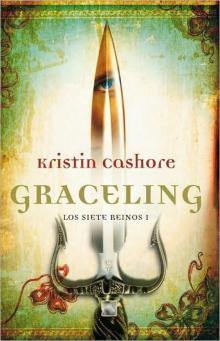 Graceling
Graceling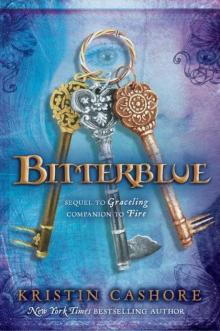 Bitterblue
Bitterblue Fire
Fire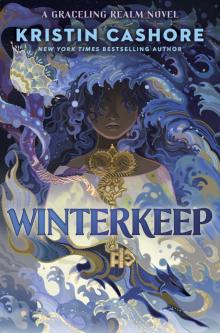 Winterkeep
Winterkeep Helen Keller in Love
Helen Keller in Love Bitterblue skt-3
Bitterblue skt-3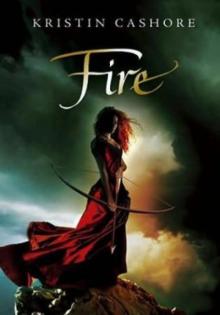 Fire skt-2
Fire skt-2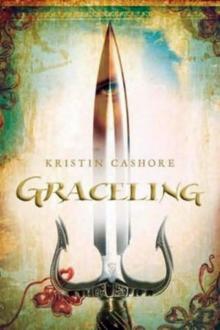 Graceling skt-1
Graceling skt-1